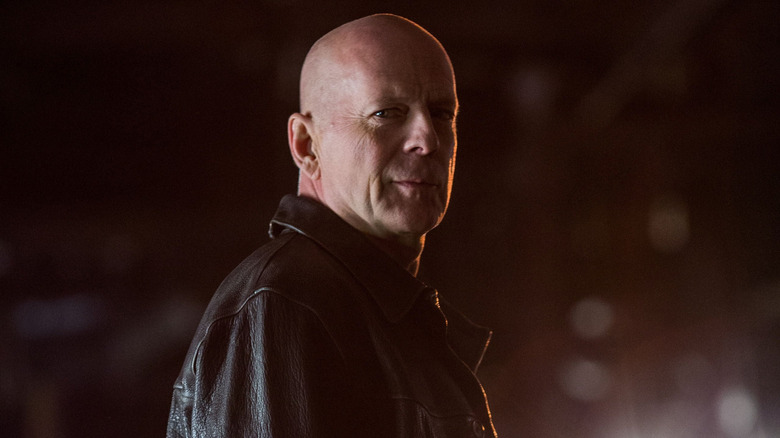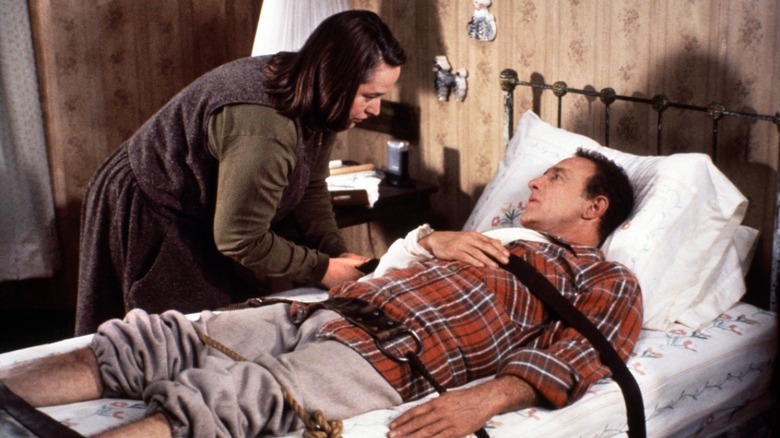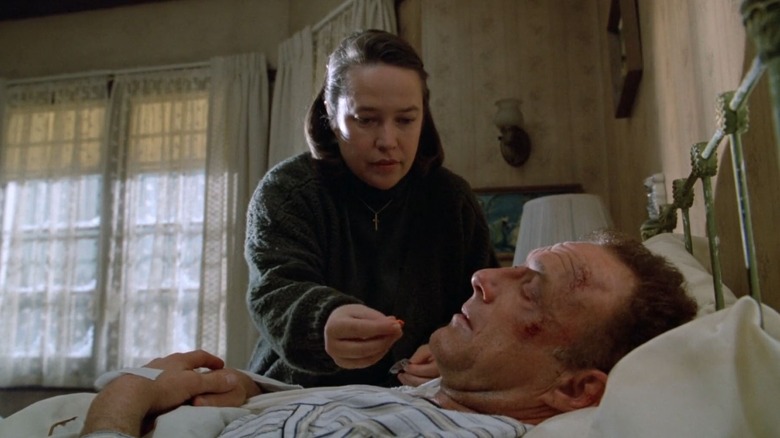
Stephen King’s 1987 novel “Misery” is ideally suited for the stage. The novel is about a celebrity author named Paul Sheldon, who is best known for writing sentimental Victorian romances starring a character named Misery Chastain. Paul has just finished his final Misery novel and celebrates by getting drunk. While drunk-driving through the snowy hills of Colorado, he swerves off the road and injured himself in a crash. Paul is rescued by Annie Wilkes, a woman who lives in a very remote cabin in the woods. Annie lays Paul in bed while his body heals, announcing that she is the world’s biggest Misery Chastain fan.
This is, of course, Paul’s nightmare. He’d rather be anywhere else than locked in a remote cabin with a super-fan. At first, Annie seems merely a little weird. Soon, though, she proves to be angry and controlling. When she learns that Misery dies in the latest novel, she snaps. She deliberately breaks Paul’s ankles to keep him prisoner, forcing him to write new Misery novels by her own demands. “Misery” is a great psychological thriller, but also a warning against the dangers of extreme fandom.
King’s novel was adapted into an acclaimed 1990 feature film by director Rob Reiner. The film starred James Caan and Kathy Bates, and it won Bates an Academy Award for her performance. It’s the only King adaptation to date to win any Oscars.
Because the bulk of “Misery” takes place in Annie’s home, adapting the novel to the stage was an easy task. In 1992, playwright Simon Moore (“Traffik”) did that very thing with a play version of “Misery” that debuted at London’s West End Theater. That staging starred Bill Paterson as Paul and Sharon Gless as Annie.
“Misery” was revived several times since, including a notable 2015 production that starred Bruce Willis as Paul and Laurie Metcalf as Annie. It ran for 102 performances.
Bruce Willis played Paul Sheldon in the 2015 stage revival of Misery
The 2015 revival of “Misery” played on Broadway at the 1200-seat Broadhurst Theater. It opened on October 22 and closed the following February, which is a pretty short run for a high-profile production starring known Hollywood actors. The American production was re-scripted by William Goldman, who also wrote the Rob Reiner film in 1990, and it was directed by Will Frears. Although Willis had been in plays in the past, “Misery” was his Broadway debut — and it turns out it would be his final Broadway production as well.
The play earned about $12 million, which seems rather modest. When it was announced that Willis would be making his Broadway debut, many became excited, eager to see what the “Die Hard” star could bring to a live performance. Shows like “Good Morning America” covered the production, and Willis talked about what a unique acting challenge theater could be, especially after a career in TV and film. “There’s no stopping,” he marveled. At an AP event, he was asked if he regretted not making his stage debut sooner. “It happens how it happens,” he pragmatically responded.
When Willis went on “Live! with Kelly and Michael” in 2015, he was asked why he was making his Broadway debut. “I was asked, and it’s a really good story,” he said. Willis seemed completely ambivalent about the entire enterprise, not threatened nor particularly enthused about the matter. He mentioned that there’s a lot of fighting and falling in the play, and jokingly compared it to “Die Hard.” Willis was at a point in his film career where he was mostly starring in low-budget thrillers, so it may seem baffling that he wasn’t more excited to be on Broadway. It wouldn’t be learned until later that Willis had begun exhibiting symptoms of aphasia.
What kind of reviews did the Broadway version of Misery receive?
For the many people who missed Willis in “Misery,” one can catch clips online. There is no official, filmed release of the play, however, and any full videos online are likely bootlegs. While Willis seems like a good casting choice for Paul Sheldon, the actor evidently didn’t bring much to the stage. Unlike his best movie performances, Willis’ “Misery” performance was panned by critics as being laconic and unengaged. An article in The Guardian collected a number of reviews, and few of the critics were kind. The Guardian’s own critic, Alexis Soloski, wrote:
“We will only believe in Paul’s peril if Paul believes in it, and Willis, though well-cast (taciturn suffering has more or less become his thing), just doesn’t seem particularly endangered. His Sheldon is a little weary, a little resigned, but not especially like a man in mortal jeopardy.”
Ben Brantley of The New York Times called Willis’ performance “vacant,” while Marilyn Stasio of Variety said he was “laid-back.” Joe McGovern of EW wrote that “Willis plays Paul with a flatness and passivity that feels too inert.” Willis was perfectly capable of giving tortured, anguished performances (see “Unbreakable” for one of his best), but it seems he wasn’t operating at the height of his powers in “Misery.”
The production closed on Broadway without much fanfare. Two years later, it was revived at the Kwadrat Theater in Poland where it was also met with modest attention. Curiously, the play experienced new life in a series of revivals in Finland. There were two noted revivals in 2019, and one in 2022. The Seinäjoki City Theatre is currently planning on a 2025 revival. Meanwhile, Willis has retired from acting because of his aphasia diagnosis and is being cared for by his family.




Leave a Reply